|
|
|
|
|
|
 Official name:
Република
Македонија (Republika Makedonija) Republic of Macedonia.
But this is only the 'unofficial' name. The official name used by the UN or at the Olympic Games etc is F.Y.R.O.M. -
this stands for Former Yugoslavian Republic of Makedonija. The reason for this ridiculous name is a
quarrel with the southern neighbour, Greece. One of the Greek provinces is called Macedonia as well. Hence, the Greek government is afraid of
a pro-Macedonian, secessionest movement. Greece even threatened with an extensive boycott (actually it was more than a threat) if Macedonia...ooops,
I mean FYROM...would dare insist on its proper name. Therefore Macedonia had to look for an alternative. Of course, Macedonians only use the name
Macedonia.
Official name:
Република
Македонија (Republika Makedonija) Republic of Macedonia.
But this is only the 'unofficial' name. The official name used by the UN or at the Olympic Games etc is F.Y.R.O.M. -
this stands for Former Yugoslavian Republic of Makedonija. The reason for this ridiculous name is a
quarrel with the southern neighbour, Greece. One of the Greek provinces is called Macedonia as well. Hence, the Greek government is afraid of
a pro-Macedonian, secessionest movement. Greece even threatened with an extensive boycott (actually it was more than a threat) if Macedonia...ooops,
I mean FYROM...would dare insist on its proper name. Therefore Macedonia had to look for an alternative. Of course, Macedonians only use the name
Macedonia.
Area: 25,713 km² (that's little more than Wales or Vermont)
Einwohner: less than 2.1 million* (2003)
Ethnic groups: ⅔ are Macedonians, 23% Albanians, 4% Turks, 2.2% Roma, 2.1% Roma and others
As of 1994 and definitely subject to change.*
Religions: Corresponding to the ethnic groups: 67% are
Macedonian-Orthodox, 30% are Muslims, others 3%.*
Time zone: Middle European time: GMT +01 hr, with daylight-saving time
(+1 hour) in summer.
Language: Macedonian. The language belongs to the South Slavic branch of
the Slavic language group. For a long time, it was just considered to be a Bulgarian dialect. Now, linguists
accepted the fact that it's a genuine language with two main dialects - Eastern and Western Macedonian.
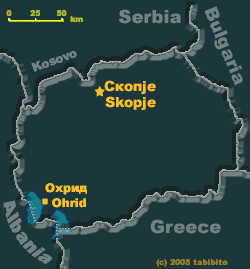 Macedonian uses the Azbuka aka Cyrillian script, but there are differences to other Slavic languages.
Altogether, 31 letters are in use, among them some letters that aren't in use any longer in Russian or Bulgarian.
These letters include (small letters in brackets) the following:
Macedonian uses the Azbuka aka Cyrillian script, but there are differences to other Slavic languages.
Altogether, 31 letters are in use, among them some letters that aren't in use any longer in Russian or Bulgarian.
These letters include (small letters in brackets) the following:
 is pronounced as a soft [ g ], non-existent in English but similar to the
[ gu ] (phon: gj) in 'Guantanamo'.
is pronounced as a soft [ g ], non-existent in English but similar to the
[ gu ] (phon: gj) in 'Guantanamo'.- S (s) Unusual in Slavic scripts. Pronounced as the
[ ds ] (phon: dz) in [ needs ]. Rarely used.
- J (j)
Also not very commmon in Slavic alphabets. Pronounced as the [ y ] (phon: j) in [ yes ].
 A mixture of 'L' and the 'soft sign', pronounced as the [ li ] (phon: lj) in [ million ]
A mixture of 'L' and the 'soft sign', pronounced as the [ li ] (phon: lj) in [ million ]  A mixture of 'N' and the 'soft sign', spoken as the [ ny/ñ ] (phon: nj) in
[ cañon/canyon ].
A mixture of 'N' and the 'soft sign', spoken as the [ ny/ñ ] (phon: nj) in
[ cañon/canyon ]. Mixture of 'K' and the 'soft sign', pronounced as the [ ky ] (phon: kj) in
[ Tokyo ].
Mixture of 'K' and the 'soft sign', pronounced as the [ ky ] (phon: kj) in
[ Tokyo ]. Pronounced as the [ dg ] (phon: dʒ) in [ hedge ].
Pronounced as the [ dg ] (phon: dʒ) in [ hedge ].
Because of these special characters, many letters usually used in Cyrillic scripts, such as [ я = ya ],
[ ю = yu ], [ щ = shch ] as well as
[ ь and ъ = hard and soft sign] are not in use.
A basic knowledge of Russian or even Bulgarian is definitely helpful. To give an example, 'thank you' in
Bulgarian is [ благодаря = blagodarya ], in
Macedonian it's [благодарам = blagodaram].
Okay, the Russian word [ Спасибо = spasibo] is completely different,
but the Russian word [ благодарить = blagodarit' ]
means 'to thank s.o.'. Mainly young people often speak some English as well. Note that a large
minority is of Albanian nationality, and naturally they prefer talking in
Albanian, which has absolutely nothing to do with Slavic languages.
For a table with the most important words in Macedonian and other Slavic languages please
→click here.
|
|
|
|
|
|
|
Macedonia - that's mountains, mountains and mountains. Sometimes also mountains. The country is landlocked, and
a large part of it occupies a plateau with an altitude of 600 to 900 metres. Right through the middle of the small country, the
Вардар (Vardar) river flows southwards before it
flows into the Aegean Sea near Thessaloniki in Greece
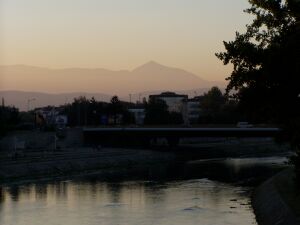
| |
Titov Vrv (probably) as seen from Skopje
|
Since the Mediterranean Sea is not far, the climate is rather moderate. The Macedonian summer is hot and
dry, the winter is not too cold. Of course, the climate in the mountains is different - it's almost certain that there's a lot of
snow. Thanks to the climate and fertile soils, almost everything can be grown in Macedonia: cereals, tobacco, rice, cotton,
cucumber, tomato etc. Agriculture is an important business in the country; many products are exported to the EU and other
countries. Natural resources are not limited to agriculture. Chrome, manganese, lead, zinc, tungsten and other ores
are exploited. Unfortunately, the underground has something else up in its sleeves: destructive earthquakes. In the year 1963,
the capital →Skopje was virtually levelled by a tremendous quake.
|
|
|
|
|
|
|
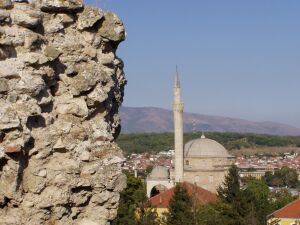
| |
Belong to the Macedonian townscape: Mosques
|
The mighty Roman empire conquered the whole Balkan incl. Macedonia during the 2nd century BC. The Roman empire broke asunder in the
4th century, leaving the Macedonian province as a part of the Eastern (aka Byzantine) Empire. And so it was ruled from
→İstanbul (at that time Constantinople). In the 7th century, first
Slavic tribes started to settle in the area. This means, that present-day Macedonians have almost nothing in common with
the ancient Macedonians. During the 9th and 10th century, Macedonia was conquered by the Bulgarian tsars Simeon and later on
by Samuel. Macedonia became the centre of the powerful →First Bulgarian Empire.
After the fall of the Bulgarian empire, Macedonia was about to become the plaything of the neighbouring powers. Bulgarians, Serbs and
Ottomans alternately invaded the region. In the year 1389, →Serbia sustained a crushing defeat
in the battle on Kosovo Polje (Kosovo Field) against the Ottoman empire. As a result, Macedonia as well as its neighbours
came under the almost 500-year long Ottoman occupation.
In 1878, the Russians won the war against the Ottoman Empire and gradually drove the Ottomans out of Europe. Now the real chaos started.
According to the Treaty of San Stefano, Macedonia was about to be a part of mighty →Bulgaria.
However, many nations decided that this Bulgaria would be too mighty, and so the Congress of Berlin decided that
Macedonia has to be handed back to the Turks. In 1893, the ИМРО (IMRO, Internal Macedonian Revolutionary
Organisation), obviously a resistance group, was founded in Илинден (Ilinden).
Ever since, the name Ilinden is well-known to every Macedonian as a symbol of independence. The IMRO initiated an uprising in 1903, which was
crushed by the Ottoman rulers.
During the First Balkan War in 1912, Bulgarians, Serbs, Greeks and Montenegrins successfully fought against the Ottoman empire.
Macedonia became a part of Bulgaria again. But only for one year. After driving out the Ottomans, the Second Balkan War started in
1913. The summary of the Second War was 'All against Bulgaria' - and Macedonia had to pay the bill. After the defeat of Bulgaria, Macedonia
was shared out between Greece and →Serbia.
The IMRO had no difficulties in finding a new enemy: The Serbs struck back and forbade the Macedonian language and culture.
Even the name 'Macedonia' itself was not allowed to mention. Nevertheless, the IMRO decided to join Tito's partisan movement and not
pro-fascist Bulgaria during the Second World War
The loyalty was rewarded after the war. Tito granted Macedonia the full republic status within the new Yugoslavia. At that time,
Macedonia was still in hopes of uniting with Greek Macedonia, but the cold war soon put an end to those ideas. At least the
Macedonian language was allowed again. Additionally, the foundation of an independent Macedonian-Orthodox Church
became possible in 1952.
In 1991, Yugoslavia was gradually falling apart. The majority of Macedonians voted to break away and form an independent state.
One year later, in 1992, Macedonia declared its independence from Belgrade - the Yugoslav government
agreed and withdraw the Yugoslav National Army without a single incident. Hence, Macedonia was the one and only former Yugoslav
republic that could break away peacefully.
It wasn't Serbia but the southern neighbour Greece that caused serious problems. Greece refused to
acknkowledge the country and made stipulations before Macedonia could join the UN and before it could get in touch with the EU.
Macedonia had to change its name and the national flag. To underline their claims, Greece even imposed a trade embargo
from 1994 to 1995. This is why the country is now called F.Y.R.O.M (see above), but problems with
Greece remain.
The Kosovo War has hit the small country hard, since trade with →Serbia had
come to nought. The embargo on Serbia worked - especially against Macedonia. Another problem was coming up soon - hundred thousands of
refugees from Kosovo swept into the country. They all went back to the Kosovo a few years later, but tension
between Macedonians and the Albanian minority, many of them are living in the north-west around
Tetovo, had already increased. Albanians demanded for their own university, Albanian as a language in schools
and more political influence. Soon fight erupted in and around Tetovo, with the Albanians being backed by intruding
UҪK fighters. With massive international help it was possible to stop the civil war - at least
for the moment. The main problem cannot be resolved completely because it has demographic reasons.
Because of the religion - most Albanians are Muslims - the birth rate of the Albanian minority is much higher than the - already negative - birth rate
of Slavic Macedonians. Therefore, many Macedonians are afraid of the ethnological upheaval. Provided that everything remains as it is today,
Macedonians will be strangers in their own country within decades.
The Kosovo War was the main reason for a dramatic economic crisis, causing an umployment rate of around 35%. This of course
had no positive influence on the ethnic conflict.
Nevertheless things look better today. When we were passing through Tetovo, the town appeared to be booming - countless new buildings
were under construction. Together with the normalisation of the political situation in →Serbia, things
can only get better.
|
|
|
|
|
|
|
Prologue:
Except for bad news about the conflict in and around Tetovo and the ethnic conflict, little is known about
Macedonia. The country is rather small, but it's blessed with stunning landscapes.
→Ohrid is the main attraction of the country, which is for a good reason.
Outside Ohrid, there are virtually no tourists at all. Actually we were planning to go to Moldova at that time,
but since we couldn't get a visa we had to change plans and went to Macedonia instead. However,
due to a permanent lack of time we could only visit Ohrid and the capital →Skopje.
I'm sure there's plenty more to see. Macedonia is definitely worth a visit.
Visa:
Macedonia seemed to have relaxed its rigid visa policy. A few years ago, every visitor needed a visa.
Me and my (Japanese) wife didn't need one in 2001, but I'm not sure about other nationalities outside
Europe, so it's worth checking with the embassy before going to Macedonia.
Money:
The local currency is called Macedonian Denar (MKD). In 2003,
one Euro was worth 61 MKD. The inflation rate seems to be quite low.
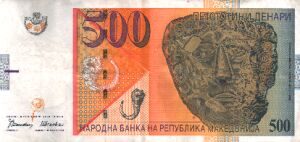
| |
Colourful Macedonian 500nar bill
|
Attention: It's almost impossible to change Macedonian money outside Macedonia,
so it's better to get rid of all the money before leaving the country. Exchange rates at border crossings are
substantially worse. There are some exchange booths here and there, but it's well worth to compare the
rate.
Costs:
Although →Ohrid is the most touristy place of the country,
it's a very cheap place. € 6 per person and night in a private room are quite common. The situation is
completely different in the capital →Skopje: Even in the youth hostel, a bed
for a night sets you back at least € 15. There might be two reasons for the gap - one is the
fact that there aren't many visitors, another one is the fact that the capital is frequented by UN personnel
spending more money than individual travelers. Eating out in Skopje is quite expensive, too. It's still
cheap to travel around in Macedonia, but travelers arriving in Skopje from
→Bulgaria will be surprised by the costs.
Bus and train fares are inexpensive. Logically, the fare for international trains is
substantially higher.
Getting there: Bus, train, plane, car - everything is possible.
For most nationalities, no visa is required for the neighbouring countries, so it's possible to move
around freely. There are several direct flights to Skopje and Ohrid
as well as some charter flights to Ohrid from various destinations in
Europe.
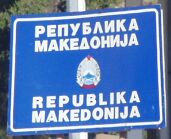
| |
Welcome to Macedonia!
|
The national railroad network is very small - all in all, it's only 700 km. Nevertheless, the one and
only international train is very convenient. It's the express train from →Belgrade to
Thessaloniki in Greece. This train is comparatively fast and not too expensive. There are also
some nice sleeping cars. Note that you won't find the name 'Thessaloniki' on Macedonian and Serbian timetables -
the Macedonian name for the town is Solun!
There's no train connection to Albania and
→Bulgaria.
Border crossings: :
There are four border crossings to Greece, three to
→Bulgaria, six to →Serbia
including the Kosovo and four to Albania.
According to several reports, it is still not recommended to go to
→Serbia via Kosovo!!! Here are some remarks about
three of the border crossings:
Гюешево (Gyueshevo) ↔
Деве Баир (Deve Bair)
is the most frequented border crossing to Bulgaria. It's the shortest way to get from →Sofia to
→Skopje. The procedure at the border is very time-consuming,
because Bulgarians and Macedonians are frisked intensively. Travelers are not checked whatsoever, but
crossing the border on a bus can take hours.
Табановце (Tabanovce) ↔
Прешево (Preshevo):
This is the main border crossing to →Serbia
on the shortest way to the Serbian capital →Belgrade. Trains cross this border, too.
Except for a short grill by Serbian border guards, it was hassle-free.
Свети Наум (Sveti Naum) ↔ Tushemisht
This is one of the border crossings to Albania at the southern shore of Lake Ohrid. We already stood in front of it
but had no time to cross it. There are direct buses from →Ohrid straight to the
crossing. 8 km away from the crossing, there's the first Albanian town called
Pogradec. Many nationalities don't require a visa. Instead of that there's a comparatively high entrance fee.
Traveling inside the country: Due to the lack of railway tracks, buses are the best way to
get around. Parts of the new motorway direction Thessaloniki and the stretch between
Tetovo and Gostivar are toll roads. The quality of the main roads is
mostly excellent.
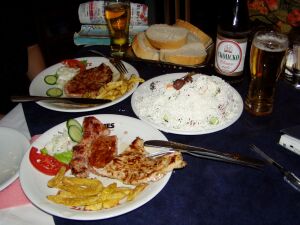
| |
Typical Macedonian dinner
|
Food and drinks:
Well, Macedonia lies in the heart of the Balkans, and so is the food: Fried meat, grilled meat,
fried minced meat, served with flabby chips and the inevitable but tasty
Shopska Salata - a cucumber and tomato salad with loads of grated sheep's cheese.
Cevapcici and Burek - greasy meat or cheese pies -
are sold everywhere. Recently, Italian restaurants mushroomed everywhere. However, there's the strange
habit of adding sour cream to everything - pasta as well as pizza. It's the typical Balkan staple diet so to say.
One exception is →Ohrid, which is quite famous for its
Ohrid trouts. Note that the prices stated in the menu are per gramm, so
a large trout can become very expensive.
Leaving alone the typical soft drinks and coffee (Turkish or as an espresso), there's a local beer called
Skopsko Pivo, which is quite okay. The most common firewater is
Rakija, which is made of grapes. Rakija is common in the neighbouring countries, too.
My experience was, that Rakija can be very tasty in Bulgaria, but the Macedonian one was
simply a nightmare. Macedonia produces very taste red wine,
which is definitely worth giving it a try!
|
|
|
|
|
|
|
www.sinf.gov.mk/english
All the latest news from and about Macedonia in English. Useful.
www.macedonia.org
Facts about Macedonia, the history, the language and more in English.
Do you have or do you know a good website on Macedonia? Don't hesitate, let me know!
After checking it, I would love to add it to the link list.
Please note that commercial websites will be declined. For e-mail link see menu on the left.
|
|
| |